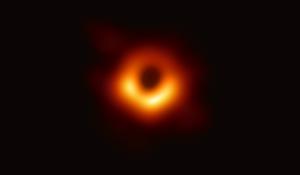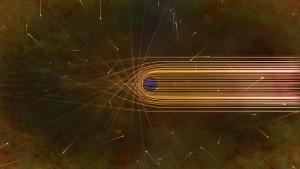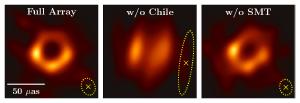Blog
Together We Can
14 April 2019
 EHT Collaboration
EHT CollaborationIn the constellation Virgo lies a faint nebulous object. It is so faint and nondescript that early astronomers took little notice of it. In the late 1700s Charles Messier listed it in his catalog as object 87. One of 103 faint fuzzy objects. Messier was interested in finding comets, so his catalog was a list of things that might look like comets at first glance, but were not comets. Objects in the night sky that you could ignore. As a result, it became known as M87.
By the early 1900s astronomers had determined that M87 was a galaxy, millions of light years from Earth. Unlike other galaxies such as Andromeda, it had no spiral structure, and it had an odd line of glowing matter that seemed to stream from its center. When Edwin Hubble created a set of categories for galaxies, he called M87 an elliptical galaxy, spherical in shape.
With the rise of radio astronomy in the 1940s, M87 was identified as a strong radio source. We learned that the line of glowing matter was a jet of material streaming away from the galactic nucleus at relativistic speeds. In the 1960s the first x-ray telescope found that the nucleus of M87 was also a powerful x-ray source. It was beginning to look like M87 could be home to a massive black hole. A then hypothetical consequence of Einstein’s theory of general relativity. An object so strange that even Einstein thought it couldn’t exist.
But Einstein was wrong. Black holes do exist. We have seen powerful and distant quasars. Tremendous beacons of radio energy powered by supermassive black holes. We have seen jets of material cast off from countless black holes. We have watched stars orbiting the black hole in our own galaxy for decades. We have heard the ringing of gravitational waves when two black holes collide and merge. We know they are real.
 Nicolle R. Fuller/NSF
Nicolle R. Fuller/NSFBut despite all the evidence, we had never directly observed a black hole. Since a black hole captures all light that enters it, and doesn’t emit light, we can never actually see a black hole. But we can see the shadow of a black hole. When a black hole is surrounded by hot gas, the light given off by the gas is deflected by the gravity of the black hole. This effect of gravitational lensing can focus light towards Earth. As a result, we would see a ring of light surrounding a truly black center. Only a black hole can create such a shadow.
In this decade an effort began to see a black hole shadow. It would be a massive project. While galactic black holes can be extremely large, they are also far away. The supermassive black hole in our own galaxy is only about 30,000 light years away, but it is relatively small for a galactic black hole. Only about 4 million solar masses. M87 is about 50 million light years away, but its black hole is a whopping 6.5 billion solar masses. Both have roughly the same apparent size in the night sky, about the same as if a baseball were placed on the surface of the Moon.
 EHT Collaboration
EHT CollaborationBoth are also surrounded by gas and dust, and can’t be seen with an optical telescope. The gas and dust are transparent to radio light, and so radio astronomers had the best chance to capture the shadow. But even then it would take a radio telescope the size of Earth to see such a small object in the sky. We can’t build such a telescope, but we can combine observations from radio telescopes all over the world to create a virtual Earth Telescope. Thus the Event Horizon Telescope (EHT) was born.
The data had to be combined through a process known as interferometry. For it to work, the exact time data gathered had to be known. All over the world the telescopic data had to be time-stamped accurate to within a tiny fraction of a second using atomic clocks. All the data gathered then had to be correlated, and then processed to produce a meaningful image. The petabytes of data couldn’t just be transfered over the Internet. Hard drives had to be shipped from all over the world to Germany and Boston. It had to be transfered to specialized supercomputers for processing. Eight radio observatories, hundreds of scientists, thousands of mechanics, engineers and technicians. All for a single fuzzy image of a shadow.
It’s a massive scientific and engineering feat, and it was only possible through collaboration on a global scale. No one person could have done this. No single country. It is truly a human endeavor. We stand in the shadow of the cosmos. Small, frail, and far too often scared. But at times we also reach out to each other in friendship and hope. Humanity is capable of wondrous things.
This image is more than just the picture of a black hole. It is a symbol of how far we can rise if we strive to be better than we are. Together we can do amazing things.
Together we can.